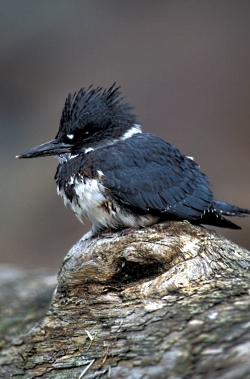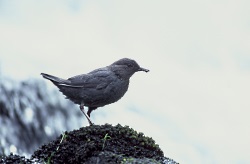
Ceryl alcyon
Courtesy US FWS,
C Schlawe, Photographer
The river begins in southeastern Idaho and runs 53.5 miles to its confluence with the Cutler Reservoir in Utah’s Cache Valley. The river transitions from mountain riparian, characterized by low growing willows and coniferous trees, to the valley’s lowland riparian where it’s dominated by a variety of shrubs, cottonwoods, and willow trees. Both wildlife and plants change along this elevational gradient giving the Logan River greater ecological diversity than might be found over hundreds of miles of a flatland river.
Rivers move water. They also transport sediments and nutrients that drop out of the water wherever the current slows, for example on floodplains during spring floods. This is why floodplains, or riparian zones, have such productive soils.
The rich soils and water available on the floodplain support a wide diversity of plants. These plants in turn provide underlying layers for insects, nesting sites for birds, and water-cooling shade that harbors the heat sensitive cutthroat trout. Plants also drop their leaves into the river providing food and nutrients to aquatic insects.
One insect found in the Logan River is the mayfly, a graceful macroinvertebrate with unique upright wings and a delicate silhouette. The female adult drops her eggs on the river’s surface which then fall to the river’s bottom. The nymphs hatch within a few days or weeks. They spend the next year moving along the river’s bottom hiding among vegetation, rocks, and fallen leaves. After a year, nymphs swim to the surface and molt into duns which fly to nearby riparian vegetation. After a couple hours duns shed their skins and become brightly colored adult mayflies called spinners.
Male spinners form a swarm over the water to attract females who fly into the swarm. Pairs mate in flight; after mating the female flies down to the river to deposit her eggs, and dies shortly thereafter.
A large number of mayflies do not complete their life cycle as they are eaten by fish, spiders, bats and birds.
Bonneville cutthroat trout, Utah’s state fish, subsist largely on aquatic insects including mayflies. Feared to be extinct in the 1970s, biologists searched the state for Bonneville cutthroat trout and when a population was found in the Logan River, wildlife managers and USU scientists teamed together to ensure the cutthroat population became and remained robust.

Courtesy US FWS
Dave Menke, Photographer
Other riparian birds, like the belted kingfisher, are fish-eaters. This handsome, crested, steel blue bird can be seen perched in the trees next to the Logan River eying fish beneath the surface. At times, kingfishers will hover directly above the water announcing their presence with a loud, rattling call. At the right time, the kingfisher dives headlong into the river using its long, sharp beak like a tweezers to catch small fish.
Rivers, like the Logan, and their riparian zones, support some of the richest biological diversity in the West. They are forceful and ever-changing, but provide all that life needs to survive and thrive in a compact area. These are dynamic ribbons of green and blue that connect land to water, plants to animals, and humans to nature.
This is Shauna Leavitt and I’m wild about Utah.
Credits:
Photos: Courtesy & Copyright ©
Audio: Courtesy & Copyright © Friend Weller, Utah Public Radio
Text: Shauna Leavitt, Utah Cooperative Fish and Wildlife Research Unit, Quinney College of Natural Resources, Utah State University
Co-Authored by: Frank Howe, Wildland Resources, Assoc. Prof. (State Cooperator), Quinney College of Natural Resources, Utah State University
Sources & Additional Reading
Geologic Map of the Logan 7.5′ Quadrangle, Cache County, Utah, Utah Geological Survey, 1996, https://ugspub.nr.utah.gov/publications/misc_pubs/mp-96-1.pdf
Williams, Stewart J. Lake Bonneville: Geology of Southern Cache Valley, Utah, Geological Survey Professional Paper 257-C, US Department of the Interior, 1962, https://pubs.usgs.gov/pp/0257c/report.pdf
Biek, Bob; Willis, Grant; Ehler, Buck; Utah’s Glacial Geology, Utah Geological Survey, September 2010, https://geology.utah.gov/map-pub/survey-notes/utahs-glacial-geology/
Hylland, Rebecca, What are Igneous, Sedimentary & Metamorphic Rocks?, Glad You Asked, Utah Geological Survey, https://geology.utah.gov/map-pub/survey-notes/glad-you-asked/igneous-sedimentary-metamorphic-rocks/
